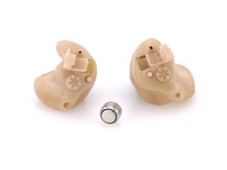By Roger Bohannan | February 12, 2019

With hearing loss remaining a growing concern around the world, a hearing aid is a necessity for many people – restoring quality of life to millions. At the heart of these instruments, the switch performs a vital function and serves as the trusted, intuitive interface between the device and its wearer.
Loss of hearing is a growing problem around the globe. According to the World Health Organization (WHO), over five percent of the world’s population – or 466 million people (432 million adults and 34 million children) – have disabling hearing loss. It is estimated that by 2050 over 900 million people – or one in every ten – will have disabling hearing loss.
There are varying levels of hearing loss. The WHO classifies disabling hearing loss as hearing loss greater than 40 decibels (dB) in the better hearing ear in adults, and a hearing loss greater than 30 dB in the better hearing ear in children. Hearing loss may be mild, moderate, severe or profound. It can affect one ear or both ears, and leads to difficulty in hearing conversational speech or loud sounds.
Restoring hearing with electronic assistance
Fortunately, help is at hand for many of those affected by hearing loss; modern digital hearing aids can help almost every individual with mild to severe hearing loss achieve better hearing.
The hearing aid is not a recent invention. The use of ear trumpets by the partially deaf dates back to the 17th century, but the miniaturized hearing aids of today are constructed with a small programmable computer and can amplify sound signals very precisely, thus improving the hearing ability of hearing-impaired people.
As technology advances, hearing aids continue to get smaller and smarter. In addition to their ultra-compact size, hearing aids can offer users many practical benefits such as wireless connectivity via Bluetooth or WiFi, allowing hearing aids to be turned into personal earphones to stream music from a smartphone or enable control of lighting, heating and door access systems.
There are several types of modern hearing aid, with the most common being behind the ear (BTE), and in the ear (ITE). BTE aids are worn with the hearing aid on top of and behind the ear, while in ITE devices all of the electronics sit in a device that fits in the ear. Both these instruments contain the same essential components: a battery, antenna, a microphone and amplifier, a receiver/loudspeaker, and an electronics package with a chip performing a vast number of calculations per second to optimize the level of amplification delivered to the user. Also integral to these products are a variety of switches such as pushbuttons, volume control switches or rocker buttons.
Relying on switches for ease of use
The switches play an essential role in increasing ease of use, and as the only interface between the device and the user they are crucial in establishing the brand quality of the hearing aid. C&K is a leader in the market for medical switches, with more than 55,000 current products supporting various industries. Its medical switch product list meets the specific demands of medical devices with ingress protection (IP) sealing, and resistance to shock and vibration, all with the performance levels necessary to meet the requirements of harsh environments.
The switches are also designed to undergo the rigors of medical device sterilization. Ethylene oxide (EtO) processing is widely used for the sterilization of healthcare devices and instruments. The process involves exposing products to ethylene oxide gas under vacuum in a sealed chamber. The sterilization standards must be validated to the customer’s specific requirements, but there is a record of success.
Switches designed for success
C&K has numerous products that are core to this market, including the KMT0, KMT2 and KXT3; many others exist. The KMT0 and KMT2 series are nano-miniature SMT top-actuated switches that come with the smallest footprint and thickness and an integrated actuator. Their extended lifecycle makes them ideal for the smallest of applications that must last a long time while withstanding the harshest of environments, including Bluetooth headsets, MP3 accessories and hearing aids.
Finally, the KXT3 series ultra-low-profile top-actuated tactile is a reliable and long-lasting switch built to meet the specific needs of engineers creating the next generation of devices, including in-ear headphones and earbuds, wearable electronics and hearing aids. The switch has a 3.0 x 2.0 mm footprint, 0.6 mm thickness and a high number of cycles.
With complex devices such as hearing aids ordering a catalog part is not always an option, and to meet specific needs, C&K can develop a switch collaboratively that can work for a particular design. It might just be a small modification that makes a switch the perfect option. Usually redesigning the entire architecture is not required. Any switch can be customized for feel, sound and force to create the exact haptic experience that is necessary to maintain the brand profile.

By Roger Bohannan, Medical Segment Leader, C&K
